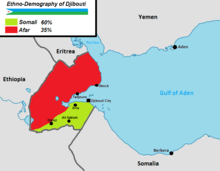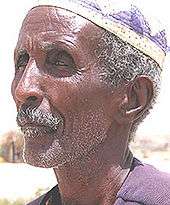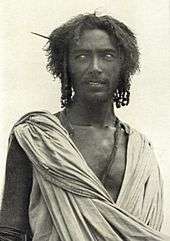Demographics of Djibouti
This article is about the demographics of Djibouti, including population density, ethnicity, education level, health, economic status, religious affiliations and other aspects of the population.
| Demographics of Djibouti | |
|---|---|
| Population | 884,017 (2018) |
| Growth rate | 2.23% (2014) |
| Birth rate | 25.27 births/1,000 population (2011 est.) |
| Death rate | 8.23 deaths/1,000 population (July 2011 est.) |
| Life expectancy | 62.4 years (2014) |
| • male | 59.93 years |
| • female | 64.94 years |
| Fertility rate | 2.79 children born/woman (2010) |
| Infant mortality rate | 53.31 deaths/1,000 infants (2012 est.)[1] |
| Age structure | |
| 0–14 years | 35% (male 132,592/female 132,114) |
| 15–64 years | 61.7% (male 206,323/female 260,772) |
| 65 and over | 3.3% (male 11,349/female 13,924) |
| Sex ratio | |
| At birth | 1.03 male(s)/female |
| Under 15 | 1 male(s)/female |
| 15–64 years | 0.8 male(s)/female |
| 65 and over | 0.81 male(s)/female |
| Nationality | |
| Nationality | Djiboutian |
| Major ethnic | Somali 55% (only in Djibouti City and Ali-Sabieh, the only Somali cities in the country) Afar 45% [and 87% of Djibouti is Afar territory) |
| Minor ethnic | French Arab Ethiopian Total 5% |
| Language | |
| Spoken | Arabic (official), French(official), Afar |
Ethnic groups

Djibouti is a multiethnic country. As of 2018, it has a population of around 884,017 inhabitants[2][3]. Djibouti's population grew rapidly during the latter half of the 20th century, increasing from about 69,589 in 1955 to around 869,099 by 2015.[4]
The two largest ethnic groups are the Somali (60%) and the Afar (35%). The Somali clan component is mainly composed of the Issas, a sub-clan of the larger Dir. The remaining 5% of Djibouti's population primarily consists of Arabs, Ethiopians and Europeans (French and Italians). Approximately 76% of local residents are urban dwellers; the remainder are pastoralists.[5] 40,000 people from Yemen live in Djibouti, counting for 4.2% of its total population.[6] 4,000 soldiers from the United States live in Djibouti, they represent 0.4% of its total population.[7]
Languages
Djibouti is a multilingual nation.[5] The majority of local residents speak Somali (350,000 speakers in Djibouti city and Ali Sabieh) and Afar (300,000 speakers) as a first language. These idioms are the mother tongues of the Somali and Afar ethnic groups, respectively. Both languages belong to the larger Afroasiatic family. There are 2 official languages in Djibouti: Arabic and French.[8]
Arabic is of religious importance. In formal settings, it consists of Modern Standard Arabic. Colloquially, about 59,000 local residents speak the Ta'izzi-Adeni Arabic dialect, also known as Djibouti Arabic. French serves as a statutory national language. It was inherited from the colonial period, and is the primary language of instruction. Around 17,000 Djiboutians speak it as a first language. Immigrant languages include Omani Arabic (38,900 speakers), Amharic (1,400 speakers), Greek (1,000 speakers) and Hindi (600 speakers).[8]
Population
| Year | Pop. | ±% p.a. |
|---|---|---|
| 1960 | 83,636 | — |
| 1969 | 149,887 | +6.70% |
| 1977 | 277,750 | +8.02% |
| 1980 | 359,247 | +8.95% |
| 1994 | 652,793 | +4.36% |
| 2000 | 722,887 | +1.71% |
| 2012 | 859,652 | +1.45% |
| Source: World Bank[9] | ||
According to the 2019 revision of the World Population Prospects[2][3], the total population was 958,923 in 2018 compared to 62,000 in 1950. The proportion of children below the age of 15 in 2010 was 35.8%, 60.9% was between 15 and 65 years of age, while 3.3% was 65 years or older.[4]
| Total population | Population aged 0–14 (%) | Population aged 15–64 (%) | Population aged 65+ (%) | |
|---|---|---|---|---|
| 1950 | 62 000 | 46.8 | 51.2 | 2.0 |
| 1955 | 70 000 | 46.0 | 52.0 | 2.0 |
| 1960 | 85 000 | 45.4 | 52.5 | 2.0 |
| 1965 | 117 000 | 44.9 | 53.0 | 2.0 |
| 1970 | 162 000 | 45.8 | 52.2 | 2.1 |
| 1975 | 224 000 | 45.9 | 52.0 | 2.1 |
| 1980 | 340 000 | 45.3 | 52.5 | 2.2 |
| 1985 | 403 000 | 44.6 | 53.1 | 2.3 |
| 1990 | 562 000 | 44.2 | 53.4 | 2.4 |
| 1995 | 627 000 | 43.4 | 54.1 | 2.5 |
| 2000 | 732 000 | 41.3 | 55.9 | 2.7 |
| 2005 | 808 000 | 38.5 | 58.5 | 3.0 |
| 2010 | 889 000 | 35.8 | 60.9 | 3.3 |
Projections
The following are UN medium variant projections; numbers are in thousands:[4]
- 2015 975
- 2020 1,065
- 2025 1,166
- 2030 1,262
- 2035 1,356
- 2040 1,447
- 2045 1,535
- 2050 1,619
Vital statistics
Registration of vital events in Djibouti is incomplete. The Population Department of the United Nations prepared the following estimates.[4]
| Period | Live births per year | Deaths per year | Natural change per year | CBR* | CDR* | NC* | TFR* | IMR* |
|---|---|---|---|---|---|---|---|---|
| 1950-1955 | 3 000 | 2 000 | 1 000 | 50.0 | 28.3 | 21.7 | 7.80 | 222 |
| 1955-1960 | 4 000 | 2 000 | 2 000 | 50.7 | 25.7 | 25.0 | 7.80 | 203 |
| 1960-1965 | 5 000 | 2 000 | 3 000 | 51.2 | 23.8 | 27.4 | 7.80 | 185 |
| 1965-1970 | 7 000 | 3 000 | 4 000 | 50.3 | 21.6 | 28.6 | 7.60 | 169 |
| 1970-1975 | 9 000 | 4 000 | 5 000 | 47.8 | 19.4 | 28.4 | 7.20 | 154 |
| 1975-1980 | 13 000 | 5 000 | 8 000 | 45.2 | 17.4 | 27.8 | 6.80 | 141 |
| 1980-1985 | 16 000 | 6 000 | 11 000 | 44.0 | 15.5 | 28.6 | 6.60 | 125 |
| 1985-1990 | 21 000 | 7 000 | 14 000 | 43.1 | 14.5 | 28.6 | 6.40 | 117 |
| 1990-1995 | 24 000 | 8 000 | 16 000 | 40.1 | 13.4 | 26.7 | 5.85 | 109 |
| 1995-2000 | 23 000 | 8 000 | 15 000 | 34.4 | 12.2 | 22.2 | 5.11 | 100 |
| 2000-2005 | 24 000 | 9 000 | 15 000 | 31.2 | 11.3 | 19.9 | 4.52 | 91 |
| 2005-2010 | 25 000 | 9 000 | 16 000 | 29.4 | 10.5 | 18.9 | 3.95 | 82 |
| * CBR = crude birth rate (per 1000); CDR = crude death rate (per 1000); NC = natural change (per 1000); IMR = infant mortality rate per 1000 births; TFR = total fertility rate (number of children per woman) | ||||||||
Births and deaths [10]
| Year | Population | Live births | Deaths | Natural increase | Crude birth rate | Crude death rate | Rate of natural increase | TFR |
|---|---|---|---|---|---|---|---|---|
| 2009 | 9 853 | 1 082 | 8 771 | |||||
| 2010 | 10 538 | 1 051 | 9 487 | |||||
| 2011 | 10 871 | 1 011 | 9 860 | |||||
Life expectancy
| Period | Life expectancy in Years[11] |
|---|---|
| 1950–1955 | 41.04 |
| 1955–1960 | |
| 1960–1965 | |
| 1965–1970 | |
| 1970–1975 | |
| 1975–1980 | |
| 1980–1985 | |
| 1985–1990 | |
| 1990–1995 | |
| 1995–2000 | |
| 2000–2005 | |
| 2005–2010 | |
| 2010–2015 |
Other demographic statistics
Demographic statistics according to the World Population Review in 2019.[12]
- One birth every 24 minutes
- One death every 65 minutes
- One net migrant every 720 minutes
- Net gain of one person every 37 minutes
The following demographic statistics are from the CIA World Factbook.[13]
Population
- 884,017 (July 2018 est.)
- 828,324 (July 2015 est.)
Age structure

- 0-14 years: 30.71% (male 136,191 /female 135,263)
- 15-24 years: 21.01% (male 87,520 /female 98,239)
- 25-54 years: 39.63% (male 145,427 /female 204,927)
- 55-64 years: 4.82% (male 18,967 /female 23,639)
- 65 years and over: 3.83% (male 15,136 /female 18,708) (2018 est.)
Median age
- total: 24.2 years. Country comparison to the world: 165th
- male: 22.4 years
- female: 25.7 years (2018 est.)
- Total: 22.8 years
- Male: 21.1 years
- Female: 24.1 years (2014 est.)
Birth rate
- 23.3 births/1,000 population (2018 est.) Country comparison to the world: 59th
Death rate
- 7.5 deaths/1,000 population (2018 est.) Country comparison to the world: 109th
Net migration rate
- 5.7 migrant(s)/1,000 population (2017 est.) Country comparison to the world: 19th
Population growth rate
- 2.13% (2018 est.) Country comparison to the world: 42nd
- 2.18% (2016 est.)
Total fertility rate
- 2.27 children born/woman (2018 est.) Country comparison to the world: 90th
Contraceptive prevalence rate
- 19% (2012)
Dependency ratios
- total dependency ratio: 56.5 (2015 est.)
- youth dependency ratio: 50.1 (2015 est.)
- elderly dependency ratio: 6.4 (2015 est.)
- potential support ratio: 15.6 (2015 est.)
Urbanization
- urban population: 77.8% of total population (2018)
- rate of urbanization: 1.67% annual rate of change (2015-20 est.)
Major cities - population
- DJIBOUTI (capital) 562,000 (2018)
Sex ratio
- at birth: 1.03 male(s)/female
- under 15 years: 1 male(s)/female
- 15-24 years: 0.89 male(s)/female
- 25-54 years: 0.71 male(s)/female
- 55-64 years: 0.85 male(s)/female
- 65 years and over: 0.82 male(s)/female
- total population: 0.86 male(s)/female (2014 est.)
Life expectancy at birth
- total population: 64 years (2018 est.) Country comparison to the world: 191st
- male: 61.4 years (2018 est.)
- female: 66.6 years (2018 est.)
- Total population: 62.4 years
- Male: 59.93 years
- Female: 64.94 years (2014 est.)
HIV/AIDS
- adult prevalence rate: 1.2% (2012 est.)
- people living with HIV/AIDS: 7,700 (2012 est.)
- deaths: 690 (2012 est.)
Major infectious diseases
- degree of risk: high
- food or waterborne diseases: bacterial and protozoal diarrhea, hepatitis A, and typhoid fever
- vectorborne disease: dengue fever
note: highly pathogenic H5N1 avian influenza has been identified in this country; it poses a negligible risk with extremely rare cases possible among US citizens who have close contact with birds (2013)
Nationality
- Djiboutien or Djiboutian
Literacy
- definition: age 15 and over can read and write
- total population: 67.9%
- male: 60%
- female: 58.4% (2003 est.)
School life expectancy (primary to tertiary education)
- total: 6 years (2011)
- male: 7 years (2011)
- female: 6 years (2011)
See also
| Wikimedia Commons has media related to Demographics of Djibouti. |
References
- "CIA – The World Factbook: Infant Mortality Rate". Archived from the original on November 19, 2012. Retrieved December 18, 2012.
- ""World Population prospects – Population division"". population.un.org. United Nations Department of Economic and Social Affairs, Population Division. Retrieved November 9, 2019.
- ""Overall total population" – World Population Prospects: The 2019 Revision" (xslx). population.un.org (custom data acquired via website). United Nations Department of Economic and Social Affairs, Population Division. Retrieved November 9, 2019.
- Population Division of the Department of Economic and Social Affairs of the United Nations Secretariat, World Population Prospects: The 2010 Revision
- "Africa :: Djibouti". CIA The World Factbook.
- https://www.aljazeera.com/indepth/features/domestic-abuse-adds-yemeni-refugee-women-woes-djibouti-180730115837586.html
- https://www.voanews.com/africa/us-signs-long-term-lease-military-base-djibouti
- "Djibouti - Languages". Ethnologue. Retrieved 6 September 2016.
- "World Bank". Retrieved 26 October 2015.
- "Demographic Yearbook". United Nations Statistics Division.
- "World Population Prospects - Population Division - United Nations". esa.un.org. Retrieved 2018-08-26.
- "Djibouti Population 2019", World Population Review
- "The World FactBook - Djibouti", The World Factbook, July 12, 2018



